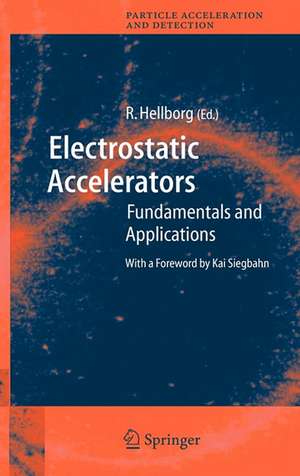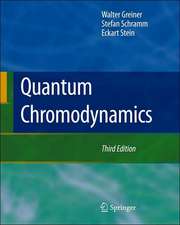Electrostatic Accelerators: Fundamentals and Applications: Particle Acceleration and Detection
Editat de Ragnar Hellborg Cuvânt înainte de K. Siegbahnen Limba Engleză Hardback – 21 apr 2005
| Toate formatele și edițiile | Preț | Express |
|---|---|---|
| Paperback (1) | 1396.26 lei 6-8 săpt. | |
| Springer Berlin, Heidelberg – 12 feb 2010 | 1396.26 lei 6-8 săpt. | |
| Hardback (1) | 1405.57 lei 6-8 săpt. | |
| Springer Berlin, Heidelberg – 21 apr 2005 | 1405.57 lei 6-8 săpt. |
Din seria Particle Acceleration and Detection
-
 Preț: 386.06 lei
Preț: 386.06 lei - 18%
 Preț: 891.33 lei
Preț: 891.33 lei -
 Preț: 426.72 lei
Preț: 426.72 lei -
 Preț: 301.08 lei
Preț: 301.08 lei - 18%
 Preț: 780.06 lei
Preț: 780.06 lei - 15%
 Preț: 583.93 lei
Preț: 583.93 lei - 18%
 Preț: 1112.48 lei
Preț: 1112.48 lei - 15%
 Preț: 656.89 lei
Preț: 656.89 lei - 24%
 Preț: 749.62 lei
Preț: 749.62 lei - 24%
 Preț: 791.78 lei
Preț: 791.78 lei - 18%
 Preț: 1230.03 lei
Preț: 1230.03 lei - 15%
 Preț: 645.96 lei
Preț: 645.96 lei - 15%
 Preț: 643.34 lei
Preț: 643.34 lei -
 Preț: 390.25 lei
Preț: 390.25 lei - 24%
 Preț: 644.82 lei
Preț: 644.82 lei - 15%
 Preț: 636.45 lei
Preț: 636.45 lei - 15%
 Preț: 645.79 lei
Preț: 645.79 lei - 15%
 Preț: 537.29 lei
Preț: 537.29 lei - 20%
 Preț: 582.50 lei
Preț: 582.50 lei - 24%
 Preț: 743.51 lei
Preț: 743.51 lei -
 Preț: 150.66 lei
Preț: 150.66 lei - 15%
 Preț: 649.54 lei
Preț: 649.54 lei - 24%
 Preț: 831.57 lei
Preț: 831.57 lei - 18%
 Preț: 735.51 lei
Preț: 735.51 lei - 18%
 Preț: 1007.03 lei
Preț: 1007.03 lei - 18%
 Preț: 963.91 lei
Preț: 963.91 lei - 24%
 Preț: 687.50 lei
Preț: 687.50 lei - 18%
 Preț: 888.80 lei
Preț: 888.80 lei
Preț: 1405.57 lei
Preț vechi: 1714.11 lei
-18% Nou
Puncte Express: 2108
Preț estimativ în valută:
269.02€ • 279.80$ • 225.44£
269.02€ • 279.80$ • 225.44£
Carte tipărită la comandă
Livrare economică 14-28 martie
Preluare comenzi: 021 569.72.76
Specificații
ISBN-13: 9783540239833
ISBN-10: 3540239839
Pagini: 620
Ilustrații: XVI, 620 p. 275 illus.
Dimensiuni: 155 x 235 x 29 mm
Greutate: 1.15 kg
Ediția:2005
Editura: Springer Berlin, Heidelberg
Colecția Springer
Seria Particle Acceleration and Detection
Locul publicării:Berlin, Heidelberg, Germany
ISBN-10: 3540239839
Pagini: 620
Ilustrații: XVI, 620 p. 275 illus.
Dimensiuni: 155 x 235 x 29 mm
Greutate: 1.15 kg
Ediția:2005
Editura: Springer Berlin, Heidelberg
Colecția Springer
Seria Particle Acceleration and Detection
Locul publicării:Berlin, Heidelberg, Germany
Public țintă
ResearchCuprins
Accelerators.- to Part I — Accelerators.- Accelerators — an Introduction.- Accelerators for Medicine.- Accelerators for Synchrotron Radiation.- The Electrostatic Accelerator.- to Part II — the Electrostatic Accelerator.- History of the Electrostatic Accelerator.- Electrostatics.- Calculation Technique for High-Voltage Equipment in Gas.- Charging Systems.- Development of Charging Belts in Russia.- Cascade Generators.- Voltage Distribution Systems — Resistors and Corona Points.- Accelerator Tubes.- Development of Tubes in Obninsk, Russia.- Stabilization.- Stripper Systems.- Charge Exchange and Electron Stripping.- Carbon Stripper Foils — Preparation and Quality.- Positive-Ion Sources.- Negative-Ion Formation Processes and Sources.- Tandem Terminal Ion Source.- Ion Optics and Beam Transport.- Beam Envelope Techniques for Ion-Optical Calculations.- Equipment for Beam Diagnostics.- Computer Control.- Radiation Protection at an Accelerator Laboratory.- Nonradiation Hazards and Safety Considerations.- Confined-Space Maintenance.- Earthquake Protection — for Pelletrons.- Earthquake Protection of the Bucharest FN Tandem Accelerator.- Electrostatic-Accelerator Free-Electron Lasers.- Research Fields and Their Technical Requirements.- to Part III — Research Fields and Their Technical Requirements.- Isotope Production for Medical Applications.- Nuclear Structure.- Nuclear Reactions.- Detection of Explosives and Other Threats Using Accelerator-Based Neutron Techniques.- Accelerator Mass Spectrometry.- Atomic Collisions in Matter.- Modification of Materials by MeV Ion Beams.- Ion Beam Analysis.- Atomic Structure.- Industrial Electron Accelerators.
Textul de pe ultima copertă
Electrostatic accelerators are an important and widespread subgroup within the broad spectrum of modern, large particle acceleration devices. They are specifically designed for applications that require high-quality ion beams in terms of energy stability and emittance at comparatively low energies (a few MeV). Their ability to accelerate virtually any kind of ion over a continuously tunable range of energies make them a highly versatile tool for investigations in many research fields including, but not limited to, atomic and nuclear spectroscopy, heavy ion reactions, accelerator mass spectroscopy as well as ion-beam analysis and modification. The book is divided into three parts. The first part concisely introduces the field of accelerator technology and techniques that emphasize their major modern applications. The second part treats the electrostatic accelerator per se: its construction and operational principles as well as its maintenance. The third part covers all relevant applications in which electrostatic accelerators are the preferred tool for accelerator-based investigations. Since some topics are common to all types of accelerators, Electrostatic Accelerators will also be of value those more familiar with other types of accelerators.
Caracteristici
The only reference book on the subject












